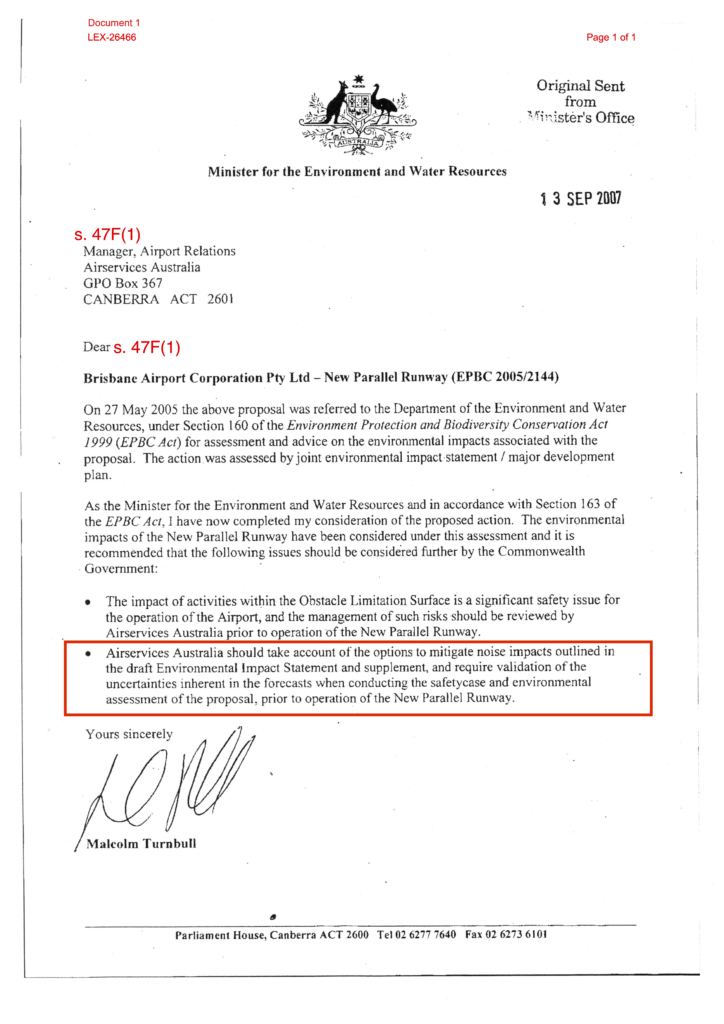60 Reasons to Protest: Reason #4 – Airservices failed to meet ministerial conditions
Major Development Proposals (MDP) such as the New Parallel Runway require ministerial approvals from both the Infrastructure Minister under the Airport Act 1996 and from the Environment Minister (for the EIS component) under the Environment Protection and Biodiversity Conservation (EPBC) Act 1999. Brisbane Airport Corporation received those approvals for the runway itself. However, Airservices was also required to obtain their own approval from the Environment Minister for the new airspace and flight path design.
BFPCA has meticulously pieced together information based on data in the 2021 ANO report and multiple FOI requests. Here is what happened, and it’s not good. Sit down for this one.
27/05/2005
In compliance with s160 of the EPBC Act 1999 Airservices wrote to the Minister for the Environment notifying that airspace management associated with Brisbane Airport’s proposed new runway was likely to have a significant impact on the environment (referral number EPBC 2005/2144).
13/09/2007
Following Airservices’ referral, the Environment Minister Malcolm Turnbull (in John Howard’s government) issued his approval subject to a key condition that is crucial for us:
Airservices Australia should take account of the options to mitigate noise impacts outlined in the draft Environmental Impact Statement and supplement, and require validation of the uncertainties inherent in the forecasts when conducting the safety case and environmental assessment of the proposal, prior to operation of the New Parallel Runway.
Dep. Environment FOI LEX 26466

07/05/2018
What did Airservices do? They rang up their mates at BAC and asked them to do the job for them.
Airservices worked closely with BAC during the design of the flight paths. We learnt from the 2021 ANO report that in 2018, BAC commissioned consultants to carry out a Noise Footprint Comparison of the flight path designs with those proposed in the 2007 EIS. Airservices advised that it participated in this assessment through a series of workshop. The report of this exercise found no significant differences between the two. The report appears to have been completed in the first half of the year, as Airservices agreed with the conclusions of the report in a letter to BAC on 07/05/2018, saying there was “no material difference” between the flight paths as then designed and those in the 2007 EIS. The letter noted a “comprehensive and detailed review” was conducted by Airservices and its “noise and environmental specialists” agreed with the conclusions. There was, however, no documentation of Airservices’ own assessment of environmental impact at this stage.
09/08/2018
Airservices wrote to the Department of Environment (with Minister Josh Frydenberg at the time) on 09/08/2018 attaching BAC’s Noise Footprint Comparison report and advising that it had taken account of options to minimise noise impacts and considered its obligations under the Minister to be satisfied. It endorsed the conclusions of the BAC Noise Footprint Comparison to the effect that there was no material difference between the flight paths proposed at that time compared to those in the 2007 EIS. However, Airservices own environmental assessment was not concluded until 21/12/2018.
Dep. Infrastructure FOI 22-146
21/12/2018
Airservices had already sent their letter to the Environment Minister, yet their own environmental assessment was not finalised until 21/12/2018. However, this assessment did not conduct a direct comparison of the flight paths between 2007 and 2018 either. It extracted a map from the 2007 EIS, applied its internal criteria for “significant” impact at 60dB(A), imposed the N60 contour onto and, since it substantially fitted within the map, determined that the significant environmental impact on the area with the map, and any requirements under the EPBC Act, had been approved under by the 2007 EIS.
The flight paths themselves had yet to be finalised and consequently the projected numbers of flights and their altitudes over particular suburbs was also not final. Airservices did not finalise their flight path design including flight numbers until April 2020.
So. Did Airservices take account of the options to mitigate noise impacts and validate any uncertainties in the 2007 MDP/EIS?
The proof is in the pudding: Of course they did not. WE WOULD NOT BE HERE IF THEY HAD DONE THEIR JOB PROPERLY.
Register for the BFPCA protest:
Discuss this in the BFPCA Facebook group:


